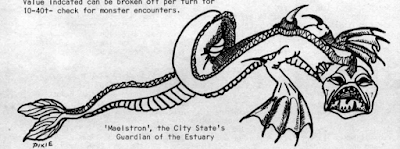 |
| Estuary of Roglaroon |
I have issues with the Estuary of Roglaroon, geologic and economic issues with it.
Geographically, the estuary describes a shallow U, short on the left side where it bends through the edge of Dearthwood past the Mermist Swamp, longer and more angled on the right from River Hagrost to the mouth. In between, despite some jagged edges, it's an almost straight line, no bends or meanders for some forty miles at the original 5 mile hex scale, 120 miles at the 15 mile hex scale I have seen some substitute. And it's incredibly uniform in width during that stretch, maybe 2 miles across at the start and three miles at the very end.
What could cut such a uniform channel? Normal stream erosion wanders as the water flows through soil and rock of varying hardness, producing a typically serpentine shape of a river. The landscape also produces significant changes in the river's width, passing through softer, more erosion prone soils to produce riverine lakes, like Lake Pepin on the Mississippi. Glaciers cut narrow channels when they encounter hard rock, producing fjords, but the banks of the Roglaroon aren't mountainous. I'm left with considering a glacial outburst flood as the agent to carve the channel. If we examine the area bounded by Ered Losthian, the Cloudwall Mountains, Quean's Waste and Ered Cantreff in the south and the Howling Hills and the hills of Dearthwood in the north; we can posit a small glacial lake of over 7,000 square miles in extent, with a moraine dam stretching between the hills just east of Caravan Crossing. Canonically, Wilderlands is a post-Ice Age world, this gives a plausible reasoning for the strange geography of the estuary.
Related, how far up stream does the saline effect the water? I would argue that based on the geography, the waters of the Roglaroon are basically salt water all the way up to the Hagrost, with water of diminishing brackishness from there to the City State. Fortunately for the City State, it gets it's drinking water from an aqueduct out of Oracle Lake, which Groaning Falls protects from contamination by storm surge.
Moving to economics, I've been having trouble imagining how ships get 140 miles up the estuary to the City State, it appears so narrow in scale that I didn't think sailing ships would have room to tack across the channel. However, digging into the detailed information in the Chivalry and Sorcery supplement
Bireme and Galley,* yes, caravels at least are nimble enough to tack back and forth across the current and are approximately the size of the ships shown on the reprints of the City State maps.
This of course led me to crunch numbers to determine how long it would take a ship to sail from the City State to Modron. There's a lot of factors involved, more with sailing ships than I had worry about driving steam ships. Sometimes the current fights you, sometimes it accelerates you and of course a tidal current is never constant. Sometimes the flood is so strong that you have to anchor for a few hours or be carried backwards. In general, your velocity made good on course (VMC), and hence distance traveled, is the cosine of the angle between the course you are steering and the tack you are on, times your true speed over ground. Because I need to take the relationships between tide, wind and heading into account, I can run it in a spreadsheet (or write code functions if I feel like it), but haven't been able to reduce it to a simple formula yet.
So, assuming the maximum tidal current in the Roglaroon is 5 knots; the ship departs the City State at the last of the flood tide; and the ship's true speed over ground equals nominal speed from Bireme and Galley based on the wind strength.
The fastest time is a mere 9 hours in a Strong Northwest Wind.
The slowest time is 60.5 hours in a Light Northeast Breeze.
Breakdown:
Five knot tidal current. The Thames in London runs 4-6 knots.
Departing on the last of the flood tide, just before slack water means the ship will ride it's anchor cable to face downstream, reducing any maneuvering to leave port.
Nominal speeds based on wind strength from Bireme & Galley for a Caravel
Light - 3.5 knots
Strong Wind - 9.5 knots
Bireme and Galley doesn't list actual wind speeds, so my estimation of their definition are based on the Beaufort scale.
Light Breeze Beaufort Scale 2-3 4-10 knots
Good Breeze Beaufort Scale 4 11-16 knots
Good Wind Beaufort Scale 5 17-21 knots
Strong Wind Beaufort Scale 6 22-27 knots
Average Voyage - Overall 27.1 hours
Average Voyage - Light Breeze 38.8 hours
Average Voyage - Strong Wind 15.3 hours
Predicted Voyage - Light Breeze at true speed over ground 28.5 hours
Predicted Voyage - Strong Wind at true speed over ground 10.5 hours
* Looks like the pictrues have disappeared from the Bireme and Galley post






